Maximum residue levels for cycloxydim
- Food safety
- Pesticide MRLs
Summary
The EU has increased the maximum residue levels (MRLs) for cycloxydim on pome fruits, peas, maize, and sugar beet roots.
EU increases MRLs for cycloxydim
Commission Regulation (EU) 2025/581 of 27 March 2025 amending Annexes II and IV to Regulation (EC) No 396/2005 of the European Parliament and of the Council as regards maximum residue levels for cycloxydim, dichlorprop-P, flupyradifurone, methyl nonyl ketone, plant oils/citronella oil, potassium sorbate and potassium phosphonate in or on certain products
Update
The EU has increased the maximum residue levels (MRLs) for cycloxydim on pome fruits, peas, maize, and sugar beet roots.
Impacted Products
Pears, quinces, medlars, loquats/Japanese medlars, peas (with pods), maize/corn, sugar beet roots
What is changing?
The changes to cycloxydim maximum residue levels (MRLs) are set out in Table 1.
Why?
Following a request for modification of the MRLs for cycloxydim on some products, the European Food Safety Authority (EFSA 2024) has concluded the data are sufficient to support the proposed MRLs for pome fruits, peas, maize/corn, and sugar beet roots.
Timeline
The new MRLs apply from 17 April 2025.
Background
MRLs are set in accordance with the rules set out in Regulation 396/2005. For information on current MRLs for other substances, please consult the EU Pesticide Residues database.
Resources
EFSA (2024) Modification of the existing maximum residue levels for cycloxydim in various crops. EFSA Journal, 22(9): e8996.
Sources
Commission Regulation (EU) 2025/581 as regards maximum residue levels for cycloxydim, dichlorprop-P, flupyradifurone, methyl nonyl ketone, plant oils/citronella oil, potassium sorbate and potassium phosphonate in or on certain products
Tables & Figures

Source: based on Commission Regulation 2025/581
Disclaimer: Under no circumstances shall COLEAD be liable for any loss, damage, liability or expense incurred or suffered that is claimed to have resulted from the use of information available on this website or any link to external sites. The use of the website is at the user’s sole risk and responsibility. This information platform was created and maintained with the financial support of the European Union. Its contents do not, however, reflect the views of the European Union.
EU increases MRLs for cycloxydim
Commission Regulation (EU) 2025/581 as regards maximum residue levels for cycloxydim, dichlorprop-P, flupyradifurone, methyl nonyl ketone, plant oils/citronella oil, potassium sorbate and potassium phosphonate in or on certain products
What is changing and why?
The maximum residue levels (MRLs) for cycloxydim have been increased as summarised in Table 1.
Following a request for modification of the MRLs for cycloxydim on some products, the European Food Safety Authority has concluded the data are sufficient to support the proposed MRLs for pome fruits, peas, maize/corn, and sugar beet roots.
Timeline
The new MRLs apply from 17 April 2025.
Tables & Figures

Source: based on Commission Regulation 2025/581
Disclaimer: Under no circumstances shall COLEAD be liable for any loss, damage, liability or expense incurred or suffered that is claimed to have resulted from the use of information available on this website or any link to external sites. The use of the website is at the user’s sole risk and responsibility. This information platform was created and maintained with the financial support of the European Union. Its contents do not, however, reflect the views of the European Union.
